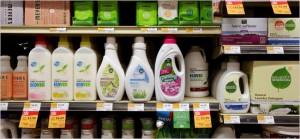While seemingly every New York Times article about green products since the start of the recession has followed the same tired pattern (people say they want environmentally friendly products but never as much as they want to save a dollar twenty-five,) a few of the recent Green Blog pieces have unearthed some telling, and surprising, quotations.
In an article this week, Stephanie Clifford and Andrew Martin came up with some candid reflections by high-level marketing teams. One of them is from the chief marketing officer at Arm & Hammer who said “Arm & Hammer Essentials cleaners may have been ahead of their time.” And what made them ahead of their time? The concentrated (and extremely economical) product was sold with an empty spray bottle. Consumers had to add their own water, after which they would only need to purchase more (non-toxic) concentrate, thereby cutting down on waste, packaging and money. Why wouldn’t consumers make the leap? “We haven’t given up on launching innovative, earth-friendly products,” the Arm & Hammer rep noted, “we’ve just taken a step back to think about how and when consumers will be ready,” he said.
America’s eco-consciousness, it turns out, is fickle, the NYT reporters note. As recession gripped the country, the consumer’s love affair with green products, from recycled toilet paper to organic foods to hybrid cars, faded like a bad infatuation. While farmers’ markets and Prius sales are humming along now, household product makers like Clorox just can’t seem to persuade mainstream customers to buy green again.
What do you think makes a consumer “ready” to buy green? What do you look for besides cost and environmental impact?

If those marketers just “went green” and didn’t put “we’re green” on their products, consumers might find themselves surprised to realize that they were already buying products from brands that WERE thinking more sustainably. I think the key is for marketers to pursue sustainability, but communicate what they are up to in more subtle ways – or ways to which many consumers already relate: like how they are being a smart, efficient, frugal, family-conscious, community-conscious buyer (green need not be mentioned).
A consumer may not realize he can go green or that it is fairly easy, so maybe the point is to blindside ’em. Deliver more green/sustainability in your products (and the way you do business overall) and then congratulate the customer for doing so on the back end.